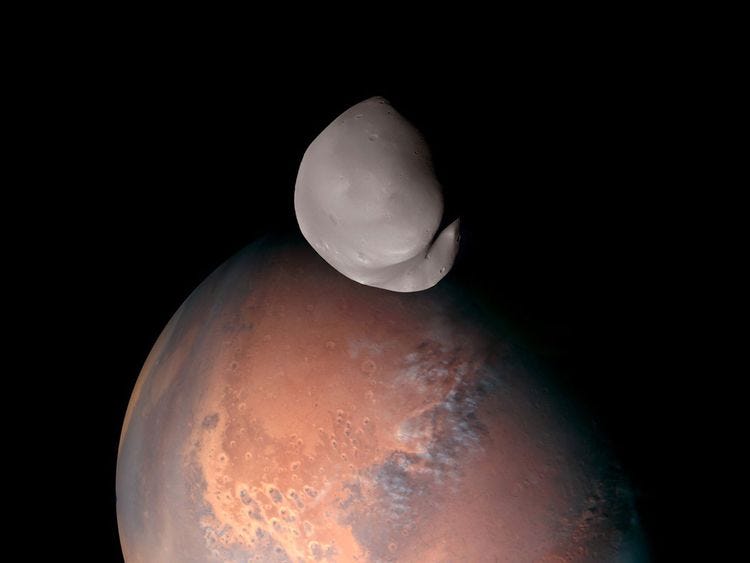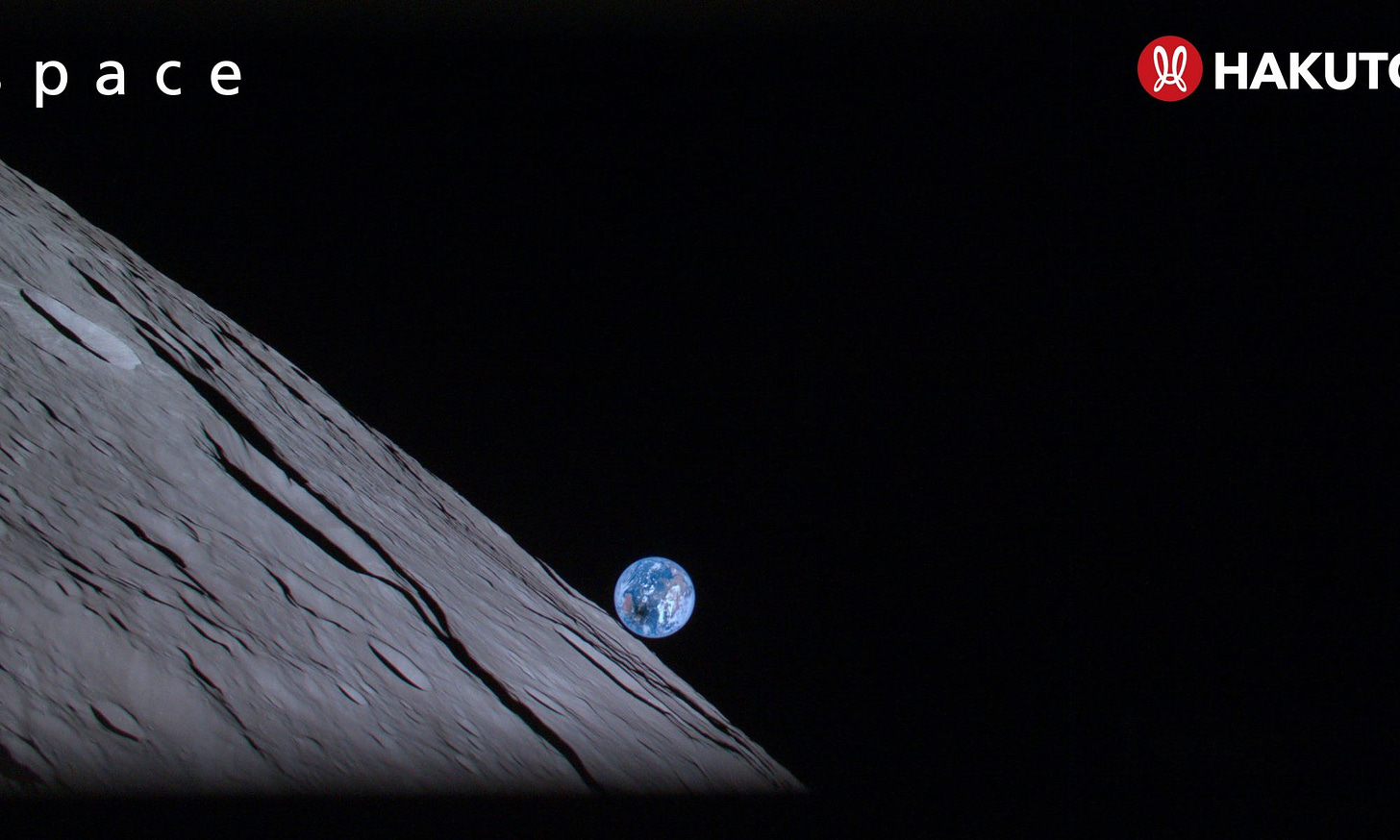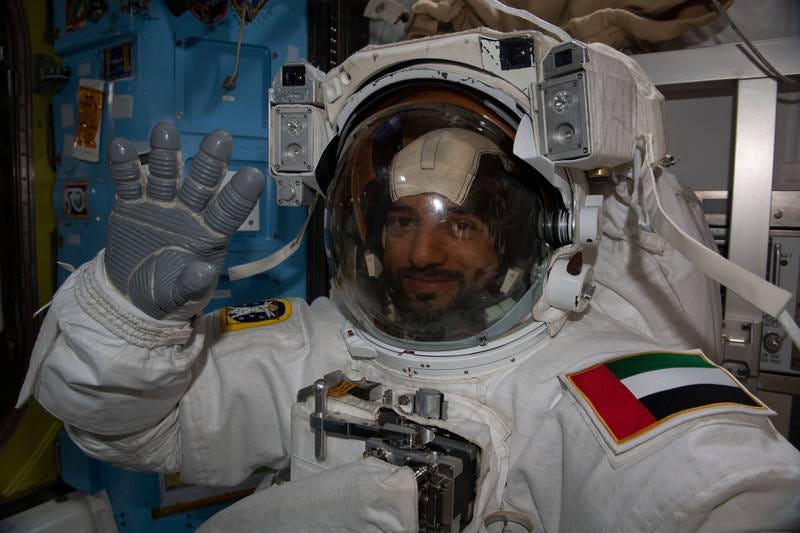Middle East Space Roundup: 23 to 29 April 2023
A summary of all the space news in the Greater Middle East over the past week, powered by AzurX

The following are the major space developments in the Greater Middle East region tracked by Middle East Space Monitor over the past week:
24 April 2023
The United Arab Emirates' Hope probe has sent back detailed photos of Deimos, Mars' smaller moon. This is the closest a spacecraft has been to Deimos in almost 50 years. The spacecraft observed the rarely explored far side of the odd-shaped moon, which is 14.5 kilometers by 11.25 km by 11.25 km. Mars' other moon, Phobos, is almost double that size and better understood since it orbits much closer to Mars - just 5,955 kilometres away. The findings suggest that Deimos is not an asteroid that got captured in Mars' orbit but instead appears to be of Martian origin - possibly from the bigger Martian moon or from Mars itself. These observations were presented at the European Geosciences Union’s general assembly in Vienna, Austria.
The launch of commercial satellites on a SpaceX Falcon Heavy rocket has been delayed, which could affect the schedule of flights to the International Space Station (ISS), including a private astronaut mission by Axiom Space that was scheduled for early May. The Ax-2 mission will likely be pushed back due to the Falcon Heavy launch delays of the ViaSat-3 Americas and Astranis Arcturus satellites. This launch was previously scheduled for 18 April 2023, but was delayed to 26 April 2203 by SpaceX. NASA is in discussions with SpaceX and Axiom Space about a new launch date, which could be announced in the next few days. The Ax-2 mission is a 10-day mission to the ISS on a Crew Dragon that will carry four private astronauts, including two from Saudi Arabia. There is limited flexibility for rescheduling this mission as a cargo mission, SpaceX CRS-28, is currently scheduled to launch on 3 June 2023. NASA wants to keep the cargo mission on schedule, which is carrying another pair of new solar arrays for the station that will be installed on two spacewalks.
Saudi Arabia is set to improve its geospatial studies, map production, and marine surveys to match global standards. The General Authority for Survey and Geospatial Information (GASGI) participated in the inaugural meeting of the international advisory committee of its UN counterpart in China, where it presented its experience in developing a national strategy aligned with the UN's Global Geospatial Knowledge and Innovation Centre Framework. The framework integrates location information to plan cities, build infrastructure, develop disaster management strategies, and manage natural resources. GASGI's president reviewed the importance of the nine strategic pathways outlined in the Integrated Geospatial Information Framework, covering governance and institutions, legal and policy, financial and data standards, innovation, partnerships, capacity and education, and communication and engagement. The GASGI and the UN Development Program have agreed on the third phase of a project that will allow the authority to improve its services and increase public awareness of its operations. The partnership aims to provide consultation services for geospatial works and the necessary infrastructure to gather data to support Saudi Vision 2030 and the Kingdom's sustainable development goals.
The UAE Minister of Economy, Abdullah bin Touq Al Marri, spoke at the City Week 2023 Forum in London about the importance of investment in new economy sectors to promote global economic growth and sustainability. Al Marri highlighted that renewable energy, circular economy, advanced technology, and the space industry can contribute significantly to a prosperous future for humanity. The UAE has invested over $40 billion in clean energy projects and plans to invest an additional $160 billion in the sector over the next three decades. The country also aims to attract $150 billion in foreign direct investment to new economic sectors, including space, by 2030.
Israel’s Gilat Satellite Networks and Intelsat are expanding their partnership, with Intelsat ordering multi-service platforms and terminals from Gilat for a multi-million dollar order to boost their in-flight connectivity and cellular backhaul capabilities. Intelsat is already a leading provider of in-flight connectivity and this expansion will empower the company with augmented capacity across North America, Latin America, Africa, and Europe to serve additional aircraft and provide an enhanced user experience for passengers. The extra capacity will also help Intelsat support the expansion of managed services with mobile network operators to provide additional coverage for satellite-based cellular backhauling. The platforms will be operational across multiple satellites, including IS-40e, IS-46, and E10B, to address the growing bandwidth demands.
25 April 2023
Thuraya Telecommunications Company, a subsidiary of UAE satellite communications provider Yahsat, has launched new firmware for its Thuraya MarineStar voice, tracking, and monitoring system. The MNB_2.0_ML firmware offers a range of features to boost productivity, optimise workflow, and comply with international maritime regulations. The new software enhances the terminal’s tracking, monitoring, fish catch reporting, and integration capabilities, introducing seven languages in one software package. It also allows for analysis of fishing locations and duration of fishing activity, which benefits vessel owners and maritime port authorities. The game-changing software supports the growth of a sustainable blue economy by equipping the fishing community with highly responsive and affordable satellite communication solutions.
Iran is preparing to launch six satellites by March 2024, according to Iranian Deputy Defence Minister Amir Rastegari. He said that Iran Electronics Industries (IEI) of the defence ministry was preparing an Iranian satellite constellation, hoping to launch two CubeSats and the country's first small satellite Tolou-3 into low Earth orbit by the specified time. Tolou-3, an Earth observation satellite, weighs 150 kilograms and can take black-and-white photos with a five-metre spatial resolution and coloured photos with a 10-metre resolution. Rastegari added that IEI had good cooperation with the Iranian Space Agency and Russia and was negotiating with the Aerospace Industries Organization of Iran's defence ministry and Russia to accelerate the satellite launches.

The Mohammed bin Rashid Space Centre (MBRSC) has expressed pride in its achievements despite the unsuccessful landing of HAKUTO-R Mission 1 on the moon. The UAE’s Rashid Rover was onboard and had been designed and built in the UAE by an Emirati team of engineers, experts, and researchers. It was to have explored new regions of the Moon in the northeast quadrant, but the spacecraft made a hard landing. Had it landed successfully, the rover would have been the first Emirati and Arab lunar mission to land on the Moon’s surface. The MBRSC has said that it will continue to work towards its goals in space exploration. The Emirati space programme has been built on bold ambition and dedication, according to Salem Al Marri, Director-General of the MBRSC.
26 April 2023
The ruler of Dubai, Sheikh Mohammed bin Rashid Al Maktoum, has announced the Rashid Rover 2 programme, a new Emirati lunar mission that will be carried out by the Mohammed bin Rashid Space Centre (MBRSC). Sheikh Mohammed and the Crown Prince of Dubai, Sheikh Hamdan bin Mohammed bin Rashid Al Maktoum, visited the Mohammed bin Rashid Space Centre and met with the team behind the UAE’s first attempt to land a rover on the Moon. Despite the failure of the first mission, Sheikh Mohammed stated that the UAE will continue to launch new space exploration missions, such as the Rashid Rover 2 project. The Rashid Rover was integrated into iSpace’s HAKUTO-R lander and successfully lifted off on 11 December 2022 from Cape Canaveral in Florida. The world’s most compact rover, the Rashid Rover is about 80cm high, 53.5cm long, and 53.85cm wide, and was built to traverse and explore the Moon's surface. The Emirates Lunar Mission (ELM) accomplished its goal of designing and building the world's most compact rover and becoming the first Emirati and Arab rover to reach lunar orbit before the landing attempt onboard iSpace’s HAKUTO-R lander. MBRSC partnered with 10 international and four UAE-based entities for the Emirates Lunar Mission's science programme.
Azercosmos, Azerbaijan’s state space corporation, is in discussions with international satellite manufacturers to launch a new Azerbaijani satellite into orbit, according to the Trend News Agency. The company stated that it is carefully studying the potential economic and non-economic benefits that the country may receive from a new satellite project in the future, with factors such as innovation, cost, and support being considered. It was widely reported last week that Azerbaijan has signed a $120 million deal to acquire two high-resolution Earth observation satellites from Israel Aerospace Industries (IAI). Also last week, Azersky, the country’s Earth observation satellite, completed its mission one year earlier than expected and communication was lost with the satellite despite measures to restore it. In other Azerbaijani space news, the chairman of Azercosmos, Samaddin Asadov, spoke on the importance of the space industry for Azerbaijan at the Space Technologies Conference in Tashkent, Uzbekistan. Discussions at the conference focused on international cooperation, opportunities of the rapidly growing global space industry, Earth observation and communication satellites, their application areas, innovations in space, and investments in this area.
27 April 2023
Yuri Borisov, the Director-General of Roscosmos, has announced that Russia is seeking to establish satellite launch contracts with countries in Africa, Europe, and Asia to strengthen its space sector and leverage the benefits of the space industry for socio-economic development. These countries include Algeria and Egypt who have reportedly agreed to work with Roscosmos on different contracts to design and launch satellites into orbit.
28 April 2023

United Arab Emirates astronaut Sultan Al Neyadi became the first Arab astronaut to perform a spacewalk. Accompanied by his American colleague Stephen Bowen, Al Neyadi spent six-and-a-half hours outside the International Space Station (ISS) to carry out two crucial tasks, including preparing the station’s exterior for a future solar array installation. The week leading up to Al Neyadi's spacewalk had seen other historic events in UAE space exploration, including observations of Mars' moon Deimos and the first Arab rover to enter lunar orbit. Al Neyadi arrived at the ISS on 3 March 2023, for a six-month mission and is now an experienced astronaut. Spacewalks are one of the riskiest activities astronauts do while on space missions, as they conduct intricate work in bulky suits while floating in microgravity more than 400km above the Earth.
29 April 2023
Türkiye's President Recep Tayyip Erdogan has announced the country's first-ever astronauts. Alper Gezeravci, a pilot in the Turkish Air Force, will be sent to the International Space Station in the last quarter of 2023 on an Axiom Space mission that will last 14 days. Meanwhile, Tuva Cihangir Atasever, a system engineer who specialises in space launch systems at Turkish missile producer Roketsan, has been chosen as the reserve candidate. The announcement comes after Türkiye established the Turkish Space Agency in 2018 and announced its space programme ambitions in 2019, which includes a crewed space mission. Erdogan stated that young people will carry Turkey “to the top league,” realising the country's dream of full strategic independence.
Be sure to catch up with space activities in the region in the next edition of Middle East Space Monitor’s space roundup!


